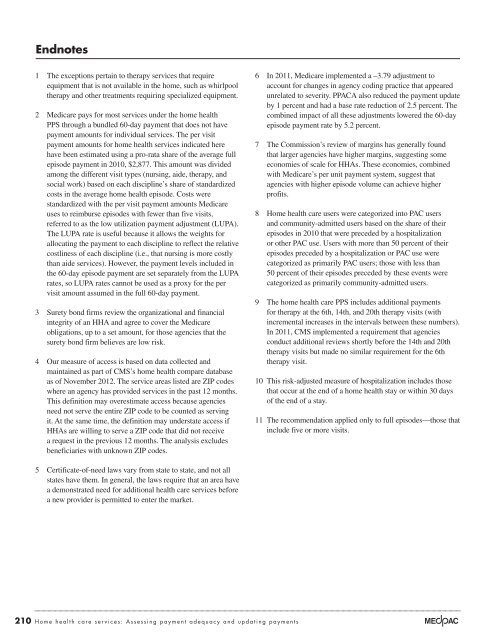Medicare Payment Policy
Medicare Payment Policy
Medicare Payment Policy
Create successful ePaper yourself
Turn your PDF publications into a flip-book with our unique Google optimized e-Paper software.
endnotes<br />
1 The exceptions pertain to therapy services that require<br />
equipment that is not available in the home, such as whirlpool<br />
therapy and other treatments requiring specialized equipment.<br />
2 <strong>Medicare</strong> pays for most services under the home health<br />
PPS through a bundled 60-day payment that does not have<br />
payment amounts for individual services. The per visit<br />
payment amounts for home health services indicated here<br />
have been estimated using a pro-rata share of the average full<br />
episode payment in 2010, $2,877. This amount was divided<br />
among the different visit types (nursing, aide, therapy, and<br />
social work) based on each discipline’s share of standardized<br />
costs in the average home health episode. Costs were<br />
standardized with the per visit payment amounts <strong>Medicare</strong><br />
uses to reimburse episodes with fewer than five visits,<br />
referred to as the low utilization payment adjustment (LUPA).<br />
The LUPA rate is useful because it allows the weights for<br />
allocating the payment to each discipline to reflect the relative<br />
costliness of each discipline (i.e., that nursing is more costly<br />
than aide services). However, the payment levels included in<br />
the 60-day episode payment are set separately from the LUPA<br />
rates, so LUPA rates cannot be used as a proxy for the per<br />
visit amount assumed in the full 60-day payment.<br />
3 Surety bond firms review the organizational and financial<br />
integrity of an HHA and agree to cover the <strong>Medicare</strong><br />
obligations, up to a set amount, for those agencies that the<br />
surety bond firm believes are low risk.<br />
4 Our measure of access is based on data collected and<br />
maintained as part of CMS’s home health compare database<br />
as of November 2012. The service areas listed are ZIP codes<br />
where an agency has provided services in the past 12 months.<br />
This definition may overestimate access because agencies<br />
need not serve the entire ZIP code to be counted as serving<br />
it. At the same time, the definition may understate access if<br />
HHAs are willing to serve a ZIP code that did not receive<br />
a request in the previous 12 months. The analysis excludes<br />
beneficiaries with unknown ZIP codes.<br />
5 Certificate-of-need laws vary from state to state, and not all<br />
states have them. In general, the laws require that an area have<br />
a demonstrated need for additional health care services before<br />
a new provider is permitted to enter the market.<br />
210 Home health care services: Assessing payment adequacy and updating payments<br />
6 In 2011, <strong>Medicare</strong> implemented a –3.79 adjustment to<br />
account for changes in agency coding practice that appeared<br />
unrelated to severity. PPACA also reduced the payment update<br />
by 1 percent and had a base rate reduction of 2.5 percent. The<br />
combined impact of all these adjustments lowered the 60-day<br />
episode payment rate by 5.2 percent.<br />
7 The Commission’s review of margins has generally found<br />
that larger agencies have higher margins, suggesting some<br />
economies of scale for HHAs. These economies, combined<br />
with <strong>Medicare</strong>’s per unit payment system, suggest that<br />
agencies with higher episode volume can achieve higher<br />
profits.<br />
8 Home health care users were categorized into PAC users<br />
and community-admitted users based on the share of their<br />
episodes in 2010 that were preceded by a hospitalization<br />
or other PAC use. Users with more than 50 percent of their<br />
episodes preceded by a hospitalization or PAC use were<br />
categorized as primarily PAC users; those with less than<br />
50 percent of their episodes preceded by these events were<br />
categorized as primarily community-admitted users.<br />
9 The home health care PPS includes additional payments<br />
for therapy at the 6th, 14th, and 20th therapy visits (with<br />
incremental increases in the intervals between these numbers).<br />
In 2011, CMS implemented a requirement that agencies<br />
conduct additional reviews shortly before the 14th and 20th<br />
therapy visits but made no similar requirement for the 6th<br />
therapy visit.<br />
10 This risk-adjusted measure of hospitalization includes those<br />
that occur at the end of a home health stay or within 30 days<br />
of the end of a stay.<br />
11 The recommendation applied only to full episodes—those that<br />
include five or more visits.


